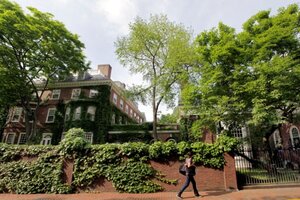Financial aid. Harvard MBA. Big pay. But student debt still burdens.
Financial aid totaled $54,000, but Joe Mihalic slashed costs to pay off his $101,000 in student loans. Despite top MBA programs' financial aid, students can still graduate with six-figure debt.

A woman walks by buildings on the campus of Harvard University in Cambridge, Mass., last week. Including living expenses and lost income from quitting a job, the costs of an MBA at Harvard and other top business schools can reach $300,000, leaving even high-earning grads with huge debts.
Elise Amendola/AP/File
Joe Mihalic wasn't thinking at all about how he was going to pay off student loans _ which would end up totaling $101,000 _ when he was accepted to Harvard Business School.
"I assumed all would take care of itself; that I would go to Harvard, get a high-paying job, and everything would be OK. I was completely naive."
Then, when he graduated from Harvard with an MBA in 2009, got the six-figure job he wanted, bought a home and started paying $1,057 a month on his student loans each month, the naivete started to dissipate. Two years after graduating, he had paid $22,000 toward his loans and saw he still had $91,000 more to go due to accumulation of interest.
It was a shocking revelation, a signal that he was trapped with overwhelming debts that would control how he could live his life. Not only had he barely made a dent in the principal after two years of payments, but he had $42,000 in interest to pay over the next 10 to 15 years.
He never questioned the value of getting his Harvard MBA, and he liked his job managing a business development division for Dell in Austin, Texas. But with debt payments arriving every month, he realized he had lost flexibility in his life. He knew that if he lost his job it could be a disaster. He would have to think twice about rocking the boat at work, balking if he was overlooked for a promotion or taking a job that paid less even if it would allow him "to make a valuable contribution to the world."
"I didn't want a gun to my head every time I thought about this," he said. "I felt trapped."
It's a revelation that few students contemplate as they apply for programs, said Sandy Kreisberg, an MBA admissions consultant. "All they want is to get into a top program."
After acceptance, they might ask about financing, but most, like Mihalic, think an MBA will deliver wealth, and they need not fret about money, Kreisberg said. That tends to be true of top MBA programs, although jobs have been more difficult to get since the 2008 financial crisis.
More top MBA programs are trying to help students with scholarships, and some compete for students with top GMAT scores by offering aid, said John Byrne, editor of Poets & Quants. For example, Mihalic received $54,000 from Harvard.
But with costs of some top MBA programs about $300,000, based on a Poets & Quants analysis that includes living expenses and lost income from quitting a job, debt can be oppressive. And when considering MBA programs, pay attention to the effect of scholarships on cost, plus the job placement rates at each school, when applying, said Byrne.
Levels of debt vary substantially between schools, even those in the top 10 or 20. At Harvard, Byrne said, the average MBA student in 2011 had $77,880 in debt, similar to Stanford at $77,599. The University of Pennsylvania's The Wharton School was highest with $114,339. Sometimes top private colleges can helpstudents more than public ones.
Despite high costs, Byrne said MBA students have the lowest default rates on student loans, about 20 percent. MBA graduates have the advantage of relatively high pay, with base salaries averaging $91,400 in 2011, said Byrne. PayScale Inc. put the median salary in 2012 for MBA graduates at $83,500, but $136,000 for MBA graduates of the country's top 30 business schools as ranked by Bloomberg Businessweek.
A higher salary allows students to take on substantial debt and live within a rule of thumb in education finance. That is: Borrow no more than what your first year of annual pay is likely to be.
In addition, it's wise to stick with federal Perkins and Federal Grad PLUS Loans because they include forgiveness programs, such as limiting debt payments to 10 percent of a person's income and forgiving debt that's left after 20 years.
While those rules can take some pressure off students, Mihalic didn't want to pay loans for 10 years. He put himself on an austere lifestyle. He sold a car, took in two roommates, stopped going to movies, didn't take dates to dinner, skipped trips and friends' weddings and even carried his own flask of liquor when he went to bars with friends.
He blogged about it, and in seven months he was debt-free except for his home. Now, he said, he's so used to an austere lifestyle, it's difficult for him to spend money.

